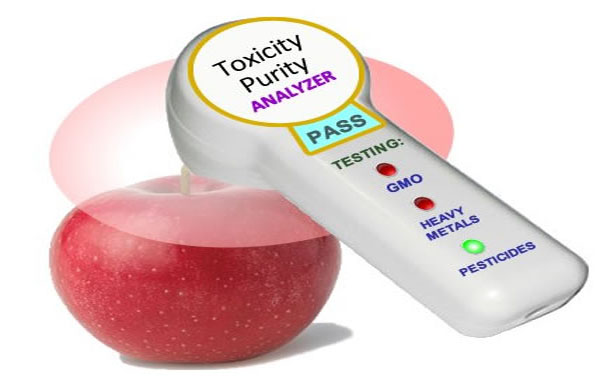http://2012thebigpicture.wordpress.com/2013/05/27/consumers-will-soon-have-devices-in-their-hands-to-detect-gmos-and-toxic-foods/
Consumers Will Soon Have Devices in Their Hands to Detect GMOs and Toxic Foods

Sheesh! I saw this on Mike Adams’ “Natural News” yesterday, put it on FB and forgot the blog…
Is this awesome or what?! And we’ll sure need it as we don’t know how long it will take to get GMOs out of the food chain. It could be fast, or it could take awhile.
It will be like having a personal “tricorder” for food. ;0)
I have a feeling that when the device first becomes available that for some of us our shopping trips will be very low-yield until our food supplies become purified and we locate better sources for food.
May 26, 2013
Consumers Will Soon Have Devices In Their Hands To Detect GMO and Toxic Foods
In the not too distant future, consumers will be able to run on-the-spot tests for environmental toxins, GMOs, pesticides, food safety and more with their smartphones and other hand-held devices.Every human being on every developed nation on Earth, whether living in a rural or isolated area, in the middle of a large city, or near an industrialized area, now contains at least 700 contaminants in their body including pesticides, pthalates, benzenes, parabens, xylenes and many other carcinogenic and endrocrine disrupting chemicals.
We are being bombarded on a daily basis by an astronomical level of toxicity, all controlled by chemical terrorists on behalf of the food industry. Morever, many of these toxins affect our fertility and those of successive generations.
It’s time for people to know exactly what they are putting in their bodies and technology is coming to the rescue. University of Illinois at Urbana-Champaign researchers have developed a cradle and app that uses a phone’s built-in camera and processing power as a biosensor to detect toxins, proteins, bacteria, viruses and other molecules.
“We’re interested in biodetection that needs to be performed outside of the laboratory,” said team leader Brian Cunningham, a professor of electrical and computer engineering and of bioengineering at Illinois. “Smartphones are making a big impact on our society — the way we get our information, the way we communicate. And they have really powerful computing capability and imaging. A lot of medical conditions might be monitored very inexpensively and non-invasively using mobile platforms like phones. They can detect molecular things, like pathogens, disease biomarkers or DNA, things that are currently only done in big diagnostic labs with lots of expense and large volumes of blood.”
“Modern biological research is also allowing an extension of laboratory devices on to small computer chips to detect biological information within DNA sequences,” said biotech specialist Dr. Marek Banaszewski. “Bioinformatic algorithms within programs will aid the identification of transgenes, promoters, and other functional elements of DNA, making detection of genetically modified foods on-the-spot and real-time without transportation to a laboratory.”
The wedge-shaped cradle created by Cunningham’s team contains a series of optical components — lenses and filters — found in much larger and more expensive laboratory devices. The cradle holds the phone’s camera in alignment with the optical components.
At the heart of the biosensor is a photonic crystal. A photonic crystal is like a mirror that only reflects one wavelength of light while the rest of the spectrum passes through. When anything biological attaches to the photonic crystal — such as protein, cells, pathogens or DNA — the reflected color will shift from a shorter wavelength to a longer wavelength.
The entire test takes only a few minutes; the app walks the user through the process step by step. Although the cradle holds only about $200 of optical components, it performs as accurately as a large $50,000 spectrophotometer in the laboratory. So now, the device is not only portable, but also affordable for fieldwork in developing nations.
In a paper published in the journal Lab on a Chip, the team demonstrated sensing of an immune system protein, but the slide could be primed for any type of biological molecule or cell type. The researchers are working to improve the manufacturing process for the iPhone cradle and are working on a cradle for Android phones as well. They hope to begin making the cradles available next year.
In addition, Cunningham’s team is working on biosensing tests that could be performed in the field to detect toxins in harvested corn and soybeans, and to detect pathogens in food and water.
Researchers at the Fraunhofer Research Institution for Modular Solid State Technologies EMFT in Regensburg have also engineered an ingenius solution to detecting toxins – a glove that recognizes if toxic substances are present in the surrounding air.
The protective glove is equipped with custom-made sensor materials and indicates the presence of toxic substances by changing colors. In this regard, the scientists adapted the materials to the corresponding analytes, and thus, the application. The color change — from colorless (no toxic substance) to blue (toxic substance detected). The researchers also envision other potential
Other handheld devices currently in development are portable chemiluminescence detectors, but based on enzyme-catalyzed reactions emitting light. The detection devices for nucleic acids, biotin associated with the target DNA provides the handle for the chemiluminescent detection. The non-radioactive DNA detection chemistry will be able to readily identify single-copy genes in transgenic plants making them suitable for GMO detection.


No comments:
Post a Comment